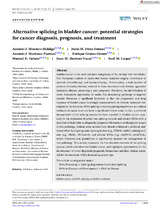Mostrar el registro sencillo del ítem
Alternative splicing in bladder cancer: potential strategies for cancer diagnosis, prognosis, and treatment
| dc.contributor.author | Montero-Hidalgo, Antonio J. | |
| dc.contributor.author | Pérez-Gómez, Jesús M. | |
| dc.contributor.author | Martínez-Fuentes, Antonio J. | |
| dc.contributor.author | Gómez-Gómez, E. | |
| dc.contributor.author | Gahete Ortiz, Manuel D. | |
| dc.contributor.author | Jiménez-Vacas, J.M. | |
| dc.contributor.author | Luque, Raúl M. | |
| dc.date.accessioned | 2023-11-24T08:04:28Z | |
| dc.date.available | 2023-11-24T08:04:28Z | |
| dc.date.issued | 2023 | |
| dc.identifier.issn | 1757-7012 | |
| dc.identifier.uri | http://hdl.handle.net/10396/26248 | |
| dc.description.abstract | Bladder cancer is the most common malignancy of the urinary tract worldwide.The therapeutic options to tackle this disease comprise surgery, intravesical orsystemic chemotherapy, and immunotherapy. Unfortunately, a wide number ofpatients ultimately become resistant to these treatments and develop aggressivemetastatic disease, presenting a poor prognosis. Therefore, the identification ofnovel therapeutic approaches to tacklethis devastating pathology is urgentlyneeded. However, a significant limitation is that the progression and drugresponse of bladder cancer is strongly associated with its intrinsic molecular het-erogeneity. In this sense, RNA splicing is recently gaining importance as a criticalhallmark of cancer since can have a significant clinical value. In fact, a profounddysregulation of the splicing process has been reported in bladder cancer, espe-cially in the expression of certain key splicing variants and circular RNAs with apotential clinical value as diagnostic/prognostic biomarkers or therapeutic targetsin this pathology. Indeed, some authorshave already evidenced a profound anti-tumor effect by targeting some splicing factors (e.g., PTBP1), mRNA splicing vari-ants (e.g., PKM2, HYAL4-v1), and circular RNAs (e.g., circITCH, circMYLK),which illustrates new possibilities to significantly improve the management ofthis pathology. This review represents the first detailed overview of the splicingprocess and its alterations in bladder cancer, and highlights opportunities for thedevelopment of novel diagnostic/prognostic biomarkers and their clinical poten-tial for the treatment of this devastating cancer type.This article is categorized under:RNA Processing > Splicing Regulation/Alternative SplicingRNA in Disease and Development > RNA in Disease | es_ES |
| dc.format.mimetype | application/pdf | es_ES |
| dc.language.iso | eng | es_ES |
| dc.publisher | Wiley | es_ES |
| dc.rights | https://creativecommons.org/licenses/by-nc-nd/4.0/ | es_ES |
| dc.source | Montero-Hidalgo, A. J., Pérez-G omez, J. M., Martínez-Fuentes, A. J., G omez-G omez,E., Gahete, M. D., Jiménez-Vacas, J. M., & Luque, R. M. (2023). Alternative splicing in bladder cancer: potentialstrategies for cancer diagnosis, prognosis, and treatment.WIREs RNA,14(3), e1760. | es_ES |
| dc.subject | Bladder cancer | es_ES |
| dc.subject | CircRNA | es_ES |
| dc.subject | Splicing | es_ES |
| dc.subject | Urothelial carcinoma | es_ES |
| dc.title | Alternative splicing in bladder cancer: potential strategies for cancer diagnosis, prognosis, and treatment | es_ES |
| dc.type | info:eu-repo/semantics/article | es_ES |
| dc.relation.publisherversion | https://doi.org/10.1002/wrna.1760 | es_ES |
| dc.relation.projectID | Gobierno de España. ID2019-105564RB-I00 | es_ES |
| dc.relation.projectID | Gobierno de España. PU18-02485 | es_ES |
| dc.relation.projectID | Gobierno de España. FPU18-06009 | es_ES |
| dc.relation.projectID | Junta de Andalucía. BIO-0139 | es_ES |
| dc.rights.accessRights | info:eu-repo/semantics/openAccess | es_ES |

